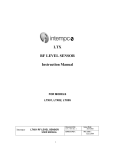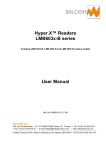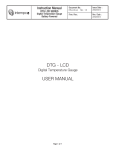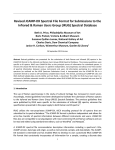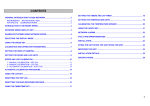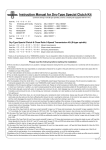Download Intempco DTG03 Manual
Transcript
DTG Series DIGITAL TEMPERATURE GAUGE User’s Guide DTG SERIES DIGITAL TEMPERATURE GAUGE USER MANUAL Document No: DTG_CONFIG USB – Instruction manual Software Rev : 2.5 Issue Date: September 2008 Rev. Date : November 2009 INTEMPCO CONTROLS LTD. DTG-CONFIG INSTRUCTION MANUAL INTRODUCTION ............................................................................................................................................3 General Description............................................................................................................................................3 Available Models ...............................................................................................................................................3 INSTALLATION .............................................................................................................................................3 Unpacking.....................................................................................................................................................3 Mechanical Installation ................................................................................................................................3 Electrical Installation ...................................................................................................................................3 Connection in stand-alone mode (no output) ..........................................................................................5 Connection in stand-alone mode (with output) .......................................................................................6 Connection in communication mode ......................................................................................................6 CONFIGURATION AND CALIBRATION WITH DTG-CONFIG SOFTWARE ..................................8 General Description .....................................................................................................................................8 Minimal Configuration ................................................................................................................................8 Install software..............................................................................................................................................8 Uninstall software.........................................................................................................................................8 Read DTG configuration ..............................................................................................................................8 DTG Programming ......................................................................................................................................9 Change DTG configuration...................................................................................................................10 Tag Name ........................................................................................................................................10 Calibration Date...............................................................................................................................10 Filtering ...........................................................................................................................................10 Sensor Failure Setting......................................................................................................................11 Change operating range and units .........................................................................................................11 Calibration.............................................................................................................................................11 Output Calibration ...........................................................................................................................12 One-point Calibration ......................................................................................................................12 Two-Point Calibration .....................................................................................................................13 Relay Output .........................................................................................................................................13 LED Display Setting .............................................................................................................................15 TECHNICAL SPECIFICATIONS ...............................................................................................................16 2 INTRODUCTION General Description The DTG, Digital Temperature Gauge, features a bright and large 4-digit LED display, optional 420mA output, optional switch output, and an optional RTD (Resistive Temperature Detector) output. The DTG wetted parts, as well as the housing, are fabricated from stainless 316. The electrical connection is either extension wires or a Micro-DC male plug. The RTD element used for temperature measurement is a standard Pt100 ohm. The DTG can be entirely readjusted and recalibrated in all its operating range by using the USB P-KIT module and the convivial DTG-CONFIG software. The DTG is a complete solution for most industrial temperature monitoring and indicating applications. It is designed as a direct replacement for Bi-Metal, Liquid Bulb and Glass Thermometers. Available Models The DTG is available with many different mechanical configurations and two temperature limits. • • Hi Temp Model (H) from - 328 to 1112 °F (from - 200 to 600 °C) Low Temp Model (L) from - 58 to 392 °F (from - 50 to 200 °C) Consult the catalogue for combinations of the different mechanical assemblies. INSTALLATION Unpacking The DTG is available in the stand-alone version or with the calibration accessories kit. In the standalone version, the DTG is delivered, pre-adjusted and calibrated, only with the instruction manual. In the calibration version, the complete set includes: • • • • • The DTG gauge (pre-adjusted and calibrated) The calibration interface module USB Cable The calibration software DTG-CONFIG for Windows (CD-ROM) with USB drivers The instruction manual Unpack the instrument carefully. Inspect all components for damage. If any damage found, or if components missing, please notify INTEMPCO representative as soon as possible prior to installation. Mechanical Installation The mechanical installation differs for each type of assembly. The same standard installation procedures as for an RTD assembly must be followed. The INTEMPCO DTG should be located for easy access for service and monitoring. Sensor electronics and the housing should not be exposed to temperature below -400C (-400F) or above 700C (1580F). This is very important when process temperatures are high and heat can conducted up to the enclosure and to the electronics. Special precaution should be made to prevent exposure to corrosive atmospheres, excessive vibration, shock or physical damage. It is preferable that the DTG is not installed in proximity to high voltage wires or other sources of high electrical noise. Electrical Installation The DTG is an instrument which, depending on its configuration, comes with 5 or 8 wires. Please refer to Table 1 and Figures 1 and 2 for color code. 3 5-wire configuration : ** Connector Type : M-12 (5 contacts) 1-Brown (V+) 2-White (Tx) 3-Blue (V-) 1 5 4 2 3 4-Black (Rx) 5-Gey (4-20 mA) FRONT VIEW Figure 1 8-wire configuration : ** Connector Type: M-12 (8 contacts) 1-White (Tx) 2 2-Brown (V+) 3 3-Green (Rx) 4 4-Yellow (Relay NO) 1 8 7 6 5 5-Grey (4-20mA) 6-Pink (Relay NC) 7-Blue (V-) 8-Red (Relay COM) FRONT VIEW Figure 2 SIGNAL V+ V4-20 mA Tx Rx Relay – COM Relay – NO Relay - NC 5-pin connector Brown Blue Grey White Black - 8-pin connector Brown Blue Grey White Green Red Yellow Pink Lead wires PVC (5) Brown Yellow or Blue Grey White Green - TABLE 1 – Color code 4 Lead wires PVC (8) Brown Blue Grey White Green Red Yellow Pink Lead wires Teflon (5) Red Black Blue White Green *** IMPORTANT *** If the DTG is not connected to the communication module, the two communication wires (Rx and Tx) must be isolated from all tension or ground. The DTG can be connected in stand-alone mode or with the communication module. Figures 3 and 4 show the electrical connection in stand-alone mode and figures 5 and 6, in communication mode. Connection in stand-alone mode (no output): • • Connect V+ wire of DTG to positive side of power supply Connect V- wire of DTG to negative side of power supply Stand-alone Mode without output NOTE: The communication wires (Tx and Rx) must be left not connected. Figure 3 5 Connection in stand-alone mode (with output): • • • • Connect V+ wire of DTG to positive side of power supply. Connect V- wire of DTG to negative side of power supply Connect 4-20mA wire of DTG at positive side of current indicator or measuring instrument Connect negative side of current indicator or measuring instrument to negative side of power supply to close current loop. Stand-alone Mode with output NOTE: The current indicator must be placed between the output (4-20mA) and the negative side of the power supply. The communication wires (Tx and Rx) must be left not connected. Figure 4 Connection in communication mode: NOTE: Before connecting the communication module to the computer proceed with the installation of the USB driver (see “Calibration and Configuration with DTG-CONFIG Software” section of this manual) • • • • • • • • Do not connect power (USB cable) until all of the steps below have been completed in order, making sure the last connection made is power (USB cable) to the interface module. Connect V+ wire of DTG to terminal no 1 (V+) of communication module. Connect V- wire of DTG to terminal no 2 (V-) of communication module. Connect Tx wire of DTG to terminal no 3 (Tx) of communication module. Connect Rx wire of DTG to terminal no 4 (Rx) of communication module. Connect 4-20mA wire of DTG to the positive side of the ampmeter. Connect negative side of the ampmeter to negative side of the power supply. Connect the communication module to the USB port of the computer. Note: In this configuration, the DTG is powered by the USB communication module. 6 Communication Mode Figure 5 IMPORTANT: When the DTG is powered by the USB communication module, the maximal load allowed on the loop is 50 ohms. In a communication mode, an exterior power supply can be used. In that case, the connection of DTG is done as follow: • • • • • • • Connect V+ wire of DTG to positive side of external power supply. Connect V- wire of DTG to negative side of external power supply. Connect Tx wire of DTG to terminal no 3 (Tx) of communication module. Connect Rx wire of DTG to terminal no 4 (Rx) of communication module. Connect terminal no 2 (V-) of communication module to negative side of external power supply. Leave terminal no 1 (V+) of communication module free. Connect the communication module to the USB port of the computer. Figure 6 7 CONFIGURATION AND CALIBRATION WITH DTG-CONFIG SOFTWARE General Description The DTG can be readjusted and recalibrated in all its operating range. To execute the readjustment and the recalibration, you will need to install the DTG-CONFIG software on your computer and to connect the DTG in communication mode configuration. Minimal Configuration To install DTG-CONFIG software, here is the minimal configuration required: • • • • • Pentium III – 600 MHz or better 10 MB of Hard Disk space 256 MB of RAM Windows XP and VISTA 1 USB port Install software *** IMPORTANT *** If you already have the former version of DTG-CONFIG installed on your computer, you will first need to uninstall it. Use the Add/Remove utility in Windows Control Panel. • • • • • Install the USB driver by running the “CP210xVCPInstaller” program located in the root directory of the CD. Run the “DTG_CONFIG.MSI” program located in the root directory of the CD. The DTG_CONFIG Setup program will automatically start. By default, the DTG_CONFIG Software will be installed in the “Program Files\DTG_CONFIG” directory. You can change the installation directory by clicking on the “Change Directory” button during the setup procedure. After the installation is complete, the MIST Software will be accessible via the Start-Program menu of Windows. Uninstall the software To uninstall the software, use the Add/Remove Programs utility in the control panel of Windows. The program and all associated files will automatically be deleted from your computer. Read DTG Configuration During start-up of DTG-CONFIG software, the configuration of the DTG connected to the communication module will be read automatically by your computer. The main window of the DTGCONFIG software will appear on the screen. (Figure 7) If no DTG is or the USB communication module is not connected properly, a communication error message will appear before the opening of the main window. You will need to make the appropriate connection (see Electrical Installation section) and click on the “Read” button to download the information. 8 Figure 7 The USB driver creates a virtual COM port when the communication module is connected. The virtual COM port number can be seen in the Device Manager of Windows. By default, the DTG_CONFIG Software is configured to read on the virtual COM port #1. If the communication module is connected to another virtual COM port, a communication error will be generated during the start-up. Once the main window appears, you can then select, in the Configuration section of the main window (upper left corner), the virtual COM port on which the device is connected (COM1 to COM8) and click on the “Read” button to download the information. The Configuration section also contains a drop down list allowing choosing from English to French language. In this same section of the window, you can find a scrolling menu entitled « Language », which allows you to select the French or English version of the software. This configuration is also saved for next utilizations. The second section of the main window, called DTG, contains the « Read » and « Program » buttons. The “Read” button activates the downloading of DTG information. The « Program » button opens the calibration and programming window. The right side section of the main window, called DTG - Configuration, contains all the information downloaded from the instrument connected to the communication module. The downloaded information includes the sensor name (Tag), the serial number, the temperature range, the set point (in case of relay output option) and the last calibration date. At the bottom of the main window, a text box named Message shows error or status messages. DTG Programming To access the programming window, simply click on the « Program » button located in the DTG section of the main window. The programming window (Figure 8) allows you to change the DTG configuration, the operating range and the recalibration of the instrument. 9 Figure 8 Change DTG configuration The configuration of the DTG includes the tag name, the last calibration date, the filtering option and the sensor failing setting. Tag name: The tag name is used to identify the instrument. It can contain a maximum of eight (8) alphanumerical characters. To set or change the tag name, simply enter the value in the text box entitled “TAG” in the GENERAL section of the programming window (top left corner). If the entered name exceeds eight characters, only the first eight will be saved. To download the sensor name to the DTG, click on the “SET” button in the GENERAL section. The “SET” button will also update the calibration date and the filtering option. Calibration Date: To modify the value of the last calibration date, enter the new date in the text boxes entitled « Calibration Date », located in the GENERAL section of the programming window. The date must be entered in Year/Month/Day format. Once the date is correctly entered, click on the “SET” button. The “SET” button will also update the tag name and the filtering option. Filtering : The filtering option allows the user to set the response time of the digital filter embedded in the DTG. There are four (4) different settings. The first, « None », corresponds to an almost instant output time delay. The other settings correspond to 1, 3 and 5 seconds. To change the filter’s time delay, click on the selection box entitled « Filtering », chose the appropriate value and click on the « SET » button located in the GENERAL section of 10 the programming window. It is recommended to set the filter at 1 second. The « SET » button will also update the sensor name and the calibration date. Sensor Failure Setting: The sensor failure setting stands for the output value at which the transmitter will be set to if a failure is detected on the RTD. The two available choices are “Low”, which corresponds to a 2,5 mA output, and « High » which corresponds to a 24 mA output. To set the failure value, click on the Option button, in the “Sensor Failure Settings” section, matching your choice and then click on the « SET » button located in the same section to update the setting in the DTG. Change operating range and units The DTG can be readjusted in its temperature range at any moment. The user can chose from a list of thirteen (13) different preset ranges or manually enter the values and preserve the factory precision standard of ± 0,4 % on any range. This section of the software, entitled OPERATION RANGE, also allows the user to change the temperature units from Celsius to Fahrenheit, and vice versa. To change the temperature units, simply click on the selection box entitled « Units » and chose the desired value. Once the value is chosen, click on the « SET » button located in the OPERATION RANGE section. NOTE : Changing the temperature units or the operating range will reset all the high precision calibrations at one or two points previously executed, but the measure precision of ± 0,25 °C + 0,4 % set by default in factory will be preserved. Every time you click on the « SET » button of the OPERATION RANGE section, a message will appear on the screen to warn you that the calibration parameters will be lost. You can then chose to continue or not with the new settings. When units change, the numerical values of the operating range stay the same since only the temperature units change. (For example, if a DTG is configured from 0 to 100 °C and the units are changed in Fahrenheit, the instrument will then be configured from 0 to 100 °F.) Once the units are changed, the values in the « Preset Ranges » selection box change automatically to correspond to the new temperature units. To readjust the DTG to one of the predefined ranges, simply click on the « Preset Range » selection box, chose the appropriate range and click on the « SET » button located in the OPERATION RANGE section. Once the new range is set, the « Actual Reading » located at the bottom of the programming window will be updated with the new values. To readjust the DTG to a range that is not included in the « Preset Range » selection box, simply enter, in the chosen temperature unit, the values corresponding to output of 4 and 20 mA in their respective text boxes. To validate this new range, click on the « SET » button located in the OPERATION RANGE section. Once this new range is set, the “Actual Reading” section, located at the bottom of the programming window, will be updated with new values. If the chosen range exceeds the fabrication limits of the DTG, an error message will appear on the screen and the DTG will not accept the new setting. Bear in mind that changing the operating range or the temperature units will reset all the calibration values. Calibration The DTG-CONFIG software allows you to execute three types of calibration. The first type is the output calibration, which allows the user to calibrate the DTG output against a current indicator. The second type is a one-point calibration, which allows the user to calibrate the DTG for a known temperature value in the operating range. Finally, the third type is a two-point calibration, which allows the user to calibrate the DTG at two known points in the operating range. 11 Output Calibration The output calibration function allows a calibration of the current output against current indicator, independent of the detector’s temperature. All DTGs already have a factory output calibration against a very high precision current indicator. If the user wants a perfect symmetry between its current indicator and the DTG, he can recalibrate the output. This recalibration is executed firstly by clicking on the “4 mA” button located in the OUPUT CALIBRATION section of the programming window. It will impose to the DTG output a theoretical value of 4,00 mA. A little dialogue box will then appear on the screen (Figure 9) and will allow the user to set exactly the output current to 4,00 mA by clicking on the (+) or (-) buttons. When the output value is exactly 4,00 mA, as measured by the current indicator, click on the « SET » button to store the new value in the DTG. Figure 9 Next, calibrate to 20 mA. To execute the calibration, click on the « 20 mA » button located in the OUTPUT CALIBRATION section in the programming window. It will impose to the DTG output a theoretical value of 20,00 mA. A little dialogue box will then appear on the screen (Figure 9) and allow the user to set exactly the output current to 20,00 mA by clicking on the (+) or (-) buttons. When the output value si exactly 20,00 mA, as measured by the current indicator, click on the “SET” button to store the new value in the DTG. Finally, calculate and store the parameters of the output calibration. To do this, click on the “Process” button located in the OUTPUT CALIBRATION section of the programming window. The DTG-CONFIG program then reads the values of 4 and 20 mA that were previously set in the DTG, calculates the output calibration parameters and downloads the new values in the DTG memory. The output calibration can be executed at any moment and not necessarily in this order (it is possible to adjust the 20 mA before the 4 mA). If necessary, only one of the two adjustments can be executed. When the output calibration parameters are calculated, the values are retrieved from the DTG’s memory. One-point Calibration The one-point calibration allows the user to compensate the DTG output as well as the LED display, so they perfectly correspond to a known temperature to which the DTG is set. To execute this calibration, a known and stable reference temperature is necessary. Set the DTG to this known reference temperature and wait 5 minutes to be sure that the reading is stable. To establish which output current corresponds to this temperature, the user can enter the reference temperature value (in the chosen temperature unit) in the corresponding text box (« For a temperature of ») located in the 1-POINT CALIBRATION section in the programming window. The theoretical output current will then be automatically calculated and displayed in the corresponding text box (« theoretical output should be »). You can also rely on the reading that appears on the 12 LED display. If the current displayed by the current indicator, or the reading of the LED display, do not correspond to the reference value, click on the (+) or (-) buttons of the “Adjustment” section to adjust the reading of the output to the right value. Each time you click on the (+) or (-) buttons, the new value is downloaded in the DTG’s memory. NOTE : The « Actual Reading » section located at the bottom of the 1-POINT CALIBRATION section displays the values calculated by the DTG-CONFIG program. This calculation is based on a digital measure (by means of the USB) and cannot exactly correspond to the current output read by the current indicator or the LED display. For more precision, use the current indicator’s measure or the LED display to make adjustments. Two-Point Calibration Two-point calibration allows the user to calibrate the DTG for two known reference temperatures in the operating range. The calibration is executed in three steps. First step: Reading of first point (« First Point »). The DTG must be at a known and stable reference temperature located in the operating range. The first point must have a value inferior to the value of the second point (« Second Point »). Once the value of the DTG’s output is stable, enter the temperature value in the « First Point » text box located in the 2-POINTS CALIBRATION section, and click on the corresponding « Read » button. The entry value is then stored in the DTG’s memory, like the reference temperature for the first point. Second step: Reading of second point. The DTG must be at a known and stable reference temperature located in the operating range. The second point must have a value superior to the value of the first point. Once the value of the DTG’s output is stable, enter the temperature value in the « Second Point » text box located in the 2POINTS CALIBRATION section, and click on the corresponding « Read » button. The entry value is then stored in the DTG’s memory, like the reference temperature for the second point. Third and last step: Calculate the calibration parameters. This calculation is executed by clicking on the “Process” button located in the 2-POINTS CALIBRATION section. The DTG-CONFIG software will then calculates and downloads the values of the DTG’s calibration parameters, based on a linear extrapolation between the two stored points. The new calibration parameters will then be downloaded and stored in the DTG’s memory. The DTG’s output is automatically recalculated with no resetting required. NOTE : The reading of the first and second point do not necessarily have to be executed during the same session or in the indicated order. Relay Output The adjustment of the set point for the relay output is executed by entering the numerical value of the set point in the « Set Point Value » text box, located in the « Relay Output » section. The units of the set point are in Celsius or Fahrenheit degrees, depending on the selected units. The user must then enter the hysteresis value that will be applied to the set point. The hysteresis level is written in percentage of the operating range. Thus, for an operating range of 100 °C, 1% represents a hysteresis of 1 °C. This value must be entered in the « Hysteresis » text box located in the « Relay Output » section. The hysteresis value corresponds to the temperature at which the relay will return to its normal state. Consult figures 10 and 11 to understand the mechanism. Finally, you must choose the operation mode of the relay. The relay can operate in normal mode, in which it is activated when the set point is reached, or it can operate in the “fail safe” mode, in which it is deactivated when the set point is reached. To operate 13 in the “fail safe” mode, check the “Fail Safe” box located in the « Relay Output » section. For the normal mode, simply deactivate the “Fail Safe” option. Once all the settings concerning the relay output are entered, click on the « SET » button to store in the DTG’s memory the new relay output operation paramaters. Example 1 : Operating Range = 100 °C Set Point = 50 °C Hysteresis = 1% Normal Mode Relay Activated Relay Deactivated 49oC 50oC Temperature Relay Activated Relay Deactivated 49oC 50oC Temperature Figure 10 Example 2 : Operating Range = 100 °C Set Point = 50 °C Hysteresis = 1% Fail Safe Mode Relay Activated Relay Deactivated 49oC 50oC Temperature Relay Deactivated Relay Activated 49oC 50oC Figure 11 14 Temperature LED Display Settings By clicking on the « LED Display Setup » button, located in the bottom portion of the programming window, the user will have access to the window allowing him to execute the different settings on the display (Figure 12). Figure 12 This window allows the user to adjust the position of the decimal point as well as the display range corresponding to the output signal 4 to 20 mA. To modify the position of the decimal point, click on the desired position in the « DECIMAL POINT SETTING » section, and then click on SET to confirm and store in the DTG’s memory. If the position of the decimal point does not permit to display the actual value, the message HI or LO will appear on the display, depending if the value to display is inferior or superior to the display limits (see table below for display limits) Position of decimal point 0 1 2 3 Minimal Value -999 -99.9 -9.99 -.999 Maximal Value 9999 999.9 99.99 9.999 The display range corresponds to the numerical values associated to a signal at 0% of the operating range and at 100% of the operating range. If, for example, the operating range is from 0 to 150 °C and that you want a display representing the temperature, enter 0 as the 0% value and 150 as the 100% value. Them click on the SET button to confirm and store the new display range in the DTG. When all settings are set, you can come back to the programming window by clicking on the « Quit » button. 15 TECHNICAL SPECIFICATIONS Sensor: Sensor Temperature Range: Setpoint: Hysteresis: Precision: Open Circuit: Warm-Up Time: Time Delay : Display : Display Resolution: RFI effect : Temperature Influence : Operating Temperature Range : Storage Temperature Range : Maximal Operating Pressure : Housing Material : Sensor Material : Window Material : Cables Material : Protection : RTD, type Pt 100, Class B See DTG table for standard ranges. Client adjustable between - 200 and 600 °C or –50 and 200 °C, depending on the model. Client adjustable between - 200 and 600 °C or –50 and 200 °C, depending on the model. Client adjustable, by default 1% of operating range. ± (0,25 °C + 0,4 % of full scale) max. with values of default calibration. ± (0,10 °C + 0,2 % of full scale) max. with one-point calibration. Software selectable at 24 mA or 2.5 mA with error message on display. 30 seconds 0.5 to 5 seconds (programmable by software) 4 DIGIT LED (decimal point programmable by software). ±0.02% of range ± 1 Digit Generally 1 % or less ≤ 0,01 % of maximal range / °C from - 40 to 80 °C (transition only) from - 40 to 80 °C 500 psi (on probe) 316 Stainless Steel 316 Stainless Steel Lexan PVC, Teflon or Silicone NEMA 4X/IP 65 Electrical Properties Supply voltage : Supply voltage effect : Current Consumption : Output : Maximal Resistance of Loop : Alarm Output : Isolation : Electrical Connection : 9-36 VDC, reverse polarity protection 0,005 % / V 15mA @ 24VDC + current output – 950 mW 50mA @ 24VDC for relay output – 1200 mW 4-20 mA (3-wire configuration), temperature linear. (VAlim. – 9V) / 20 mA Relay type SPDT 0.5A @ 240 VAC Input/Output 500 VDC Micro-DC male connector, aluminium anodized black or 316 Stainless Steel or cable only. 16

















